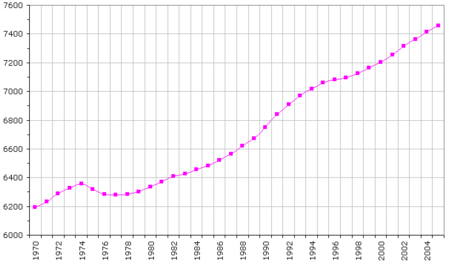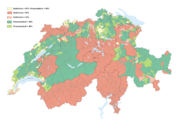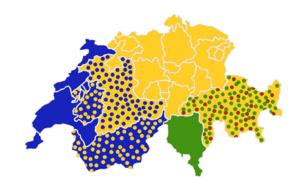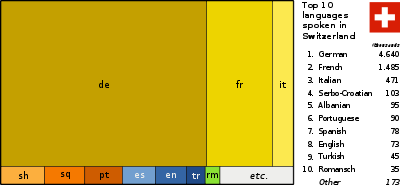Demographics of Switzerland
Switzerland sits at the crossroads of several major European cultures, which have heavily influenced the country's languages and cultural practices. Switzerland has four national languages: German, French, Italian (three Confederation official languages), and Romansh (official only in the Grisons). The German spoken in the German speaking part of Switzerland is predominantly a range of Swiss dialects, but newspapers and some broadcasts use High German as used in Germany. Many Swiss speak more than one language. English is widely known, especially among professionals.
More than 75% of the population live in the central plain, which stretches between the Alps and the Jura Mountains and from Geneva in the southwest to the Rhine River and Lake Constance in the northeast. Resident foreigners and temporary foreign workers make up about 20% of the population.
Almost all Swiss are literate. Switzerland's 13 institutes of higher learning enrolled 99,600 students in the academic year of 2001-02. About 25% of the adult population hold a diploma of higher learning.
The constitution guarantees freedom of worship and the different religious communities co-exist peacefully.
Switzerland consistently ranks high on quality of life indices, including per capita income, concentration of computer and internet usage per capita, insurance coverage per individual, and health care rates. For these and many other reasons, such as the four languages, it serves as an excellent test market for businesses hoping to introduce new products into Europe.

Population
Total of registered residents (numbers relate to 31 December):
| year | total | male | female | Swiss | foreign |
| 2006[1] | 7,507,300 | 3,678,500 (49.0%) | 3,828,800 (51.0%) | 5,953,700 (79.3%) | 1,553,600 (20.7%) |
| 2005 | 7,459,100 | 3,652,500 | 3,828,800 | 5,917,200 | 1,541,900 |
| 2004 | 7,415,100 | ||||
| 2003 | 7,364,100 | ||||
| 2002 | 7,313,900 | ||||
| 2001 | 7,255,700 | ||||
| 2000 | 7,204,100 | ||||
| 1990 | 6,750,700 | 3,298,300 (48.9%) | 3,452,400 (51.1%) | 5,623,600 (83.3%) | 1,127,100 (16.7%) |
| 1980 | 6,335,200 | 3,082,000 (48.6%) | 3,253,300 (51.4%) | 5,421,700 (85.6%) | 913,500 (14.4%) |
| 1900 | ca. 3,300,000 | ||||
| 1815 | ca. 1,700,000 |
Age structure
- 0-20 years: 1,6 million (22%)
- 20-64 years: 4,6 million (62%)
- 65 and over: 1,2 million (16%)
Data (2005 est.)
As population growth curbs, the percentage of elderly people increases. In July 2006, the Swiss Federal Office of Statistics published a projection estimating that by 2050, one in three adult Swiss will be of retirement age (as opposed to one in five in 2005). Total population was projected to stagnate in 2036 at around 8.1 million and fall slightly to 8 million in 2050. The predicted age structure for 2050 is:
- 0-20 years: 1,4 million (18%)
- 20-64 years: 4,4 million (55%)
- 65 and over: 2,2 million (27%)
Population growth rate
During the 19th and 20th centuries, population growth rate has been at 0.7% to 0.8%, with a doubling time of ca. 90 years. In the later 20th century, the growth rate has fallen below 0.7% (1980s: 0.64%; 1990s: 0.65%), and in the 2000s it has risen again slightly (2000–2006: 0.69%), mostly due to immigration.
Birth rate
10.4 births/1,000 population (2000 est.)
Death rate
8.75 deaths/1,000 population (2000 est.)
Net migration rate
1.38 migrant(s)/1,000 population (2000 est.)
Sex ratio
| at birth: | 1.05 male(s)/female |
| under 15 years: | 1.05 male(s)/female |
| 15-64 years: | 1.03 male(s)/female |
| 65 years and over: | 0.68 male(s)/female |
| total population: | 0.97 male(s)/female |
Data: (2000 est.)
Infant mortality rate:
4.53 deaths/1,000 live births (2000 est.)
Life expectancy at birth
| total population: | 81.8 years |
| male: | 79.4 years |
| female: | 84.2 years |
Data: (2007) [2]
Total fertility rate
1.46 children born/woman (total)
1.33 children born/Swiss woman
1.86 children born/non-Swiss woman
(2000 est.) [3]
Nationality
- Further information: Swiss (people)
The number of registered resident foreigners was 1,001,887 (16.17%) in 1970. This amount decreased to 904,337 (14.34%) in 1979, and has increased steadily since that time, passing the 20% mark during 2001 and rising to 1,524,663 (20.56%) in 2004. The number of Swiss citizens thusly numbered about 5.9 million in that year.
In 2000, 1.3 million resident foreigners (86.9%, or 17.8% of the total population [4]), had European citizenship (Ex-Yugoslavian: 362,000; Italian: 322,000; Portuguese: 142,000; German: 112,000; Albanians: about 92,000 the most from a non-European Union member country; Spanish: 83,000; French: 63,000; Austrian: 30,000); 92,000 residents were from Asia; 84,000 Turkish; 51,000 from the Americas; 50,000 from Africa; about 20,000 Tibetans from Tibet; and 3,000 from Oceania.
In 2004, 35,700 people acquired Swiss citizenship according to Swiss nationality law, a figure slightly larger than that of the previous year (35,424), and four times larger than the 1990 figure (8,658). About a third of those naturalized are from a successor state of Former Yugoslavia: 7,900 Serbia-Montenegro, 2,400 Bosnia-Herzegowina, 2,000 Macedonia, 1,600 Croatia. 4,200 were from Italy, 3,600 from Turkey, 1,600 from Sri Lanka, 1,200 from Portugal, and 1,200 from France. [5]
In 2004, 623,100 Swiss citizens (8.9%) lived abroad, the largest group in France (166,200), followed by the USA (71,400) and Germany (70,500). (see Swiss diaspora).
Religions

In 2000, 5.78 million residents (79.2%, compared to 93.8% in 1980) were Christian (Roman Catholic 41.8%, Protestant 35.3%, Orthodox 1.8%). 809,800 (11.1%, compared to 3.8% in 1980) were without any religious affiliation. 310,800 (4.3%) were Muslim (compared to 0.9% in 1980), 17,900 (0.2%) were Jewish. These numbers are based on membership in a congregation, not on direct statements of belief. The 2005 Eurobarometer poll[1] found 48% of Swiss residents to be theist, 39% expressing belief in "some sort of spirit or life force", 9% atheist and 4% agnostic.
Languages

The four national languages of Switzerland are German, French, Italian and Romansh. Native speakers number about 64% (4.6 million) for German (mostly Swiss German dialects), 20% (1.5 million, mostly Swiss French, but including some Franco-Provençal dialects) for French, 7% (0.5 million, mostly Swiss Italian, but including Lombardic dialects) for Italian and less than 0.5% (35,000) for Romansh.
The Cantons of Fribourg, Berne, Valais and Grisons are officially bi- or trilingual (Grisons). In fact, Jura and Ticino are also bilingual, but the traditional German minority is very small.
The non-official language with the largest group of native speakers is Serbo-Croatian with 103,000 speakers in 2000, followed by Albanian with 95,000, Portuguese with 89,500, Spanish with 77,500, English with 73,000, Macedonian 61,300,[2] and a total of 173,000 speakers of other languages, amounting to roughly 10% of the population with a native language not among the four official languages.[3]

Literacy
Definition: age 15 and over can read and write
Total population: 99% (1980 est.) (no separate numbers for sexes)
Delinquency
- Further information: Gun crime in Switzerland
The police registered a total of 332,452 criminal offenses in 2003, including 187 killings and 547 cases of rape. In the same year, 86,186 adults (85% of them male, 51.1% of them Swiss citizens) were convicted under criminal law. 54.8% of convictions were for traffic offences, 37.9% of punishments were in the form of fines only. In the same year, 13,483 minors (82% of them male, 61.4% of them of Swiss nationality, 79.5% aged between 15 and 18) were convicted.
Convictions for infliction of bodily harm have steadily increased throughout the 1990s and 2000s, with 23 convictions for serious injury and 831 for light injury in 1990 as opposed to 78 and 2,342, respectively, in 2005. Convictions for rape have also slightly increased, fluctuating between 61 and 100 cases per year in the period 1985 to 1995, but between 100 and 113 cases in the period 2000 to 2005. Consistent with these trends, convictions for threats or violence directed against officials has consistently risen in the same period, from 348 in 1990 to 891 in 2003.[6][7]
| convictions | 2001 | 2002 | 2003 | 2004 | 2005 |
| criminal law | 22,324 | 24,055 | 26,794 | 30,120 | 29,952 |
| traffic regulations | 45,237 | 45,868 | 48,160 | 52,634 | 48'332 |
| narcotics | 8,163 | 8,691 | 9,386 | 11,220 | 10,881 |
convictions under criminal law:
| year | convictions | male | Swiss |
| 1985 | 22,207 | 81.4% | 67.6% |
| 1990 | 21,692 | 85.1% | 58.5% |
| 1995 | 18,977 | 83.5% | 55.3% |
| 2000 | 22,316 | 85.1% | 48.9% |
| 2001 | 22,324 | 84.0% | 50.8% |
| 2002 | 24,055 | 84.5% | 48.5% |
| 2003 | 26,794 | 84.2% | 46.9% |
| 2004 | 30,120 | 84.6% | 47.1% |
| 2005 | 29,952 | 84.4% | 48.8% |
At the end of 2006, 5,888 people were interned in Swiss prisons, one third of them on remand (or 79 in 100,000, comparable to the ratio in France; the USA have 740, Germany has 98 and Iceland has 29 in 100,000), 31% of them Swiss citizens, 69% resident foreigners or illegal immigrants; excluding remand: 36% Swiss or 32 in 100,000, 64% foreigners or 160 in 100,000.
While the crime rate among resident foreigners is significantly higher (by a factor 3.7 counting convictions under criminal law in 2003), this is mainly due to the different demographic composition, the non-naturalized population consisting of a significantly higher ratio of young males (according to a statement issued by the federal statistics office in 1996[8]) In 1997, there were for the first time more foreigners than Swiss among the convicts under criminal law (out of a fraction of 20.6% of the total population at the time). In 1999, the Federal Department of Justice and Police ordered a study regarding deliquency and nationality (Arbeitsgruppe "Ausländerkriminalität"), which in its final report (2001) found that a conviction rate under criminal law about 12 times higher among asylum seekers (4%), while the conviction rate among other resident foreigners was about twice as high (0.6%) compared to Swiss citizens (0.3%).[9]
See also
- List of Swiss people
- Switzerland
- Politics of Switzerland
- Poverty in Switzerland
References
- ↑ available at http://europa.eu.int/comm/public_opinion/archives/ebs/ebs_225_report_en.pdf
- ↑ Pub_Auslaender_D.pdf
- ↑ Lüdi, Georges; Werlen, Iwar. Recensement Fédéral de la Population 2000 – Le Paysage Linguistique en Suisse. Neuchâtel, avril 2005: Office fédéral de la statistique. Accessed from Encyclopédie statistique de la Suisse on 5 January 2006.
- ↑ Swiss Federal Statistical Office, Federal Population Census 2000
External links
|
|||||||||||
